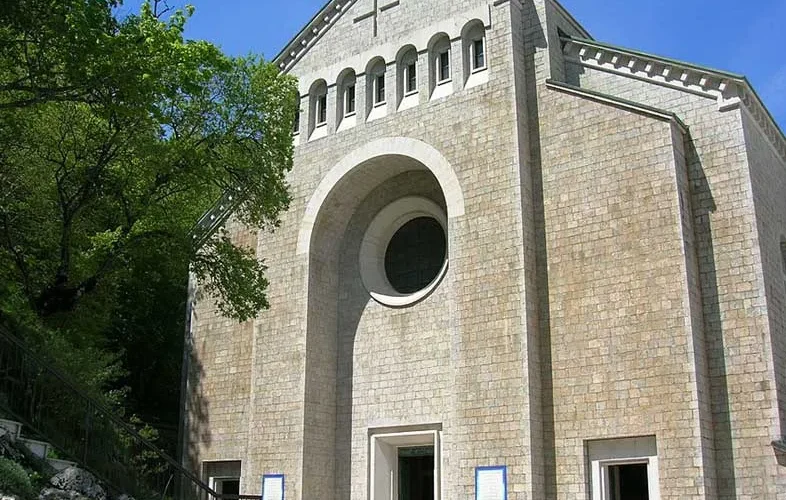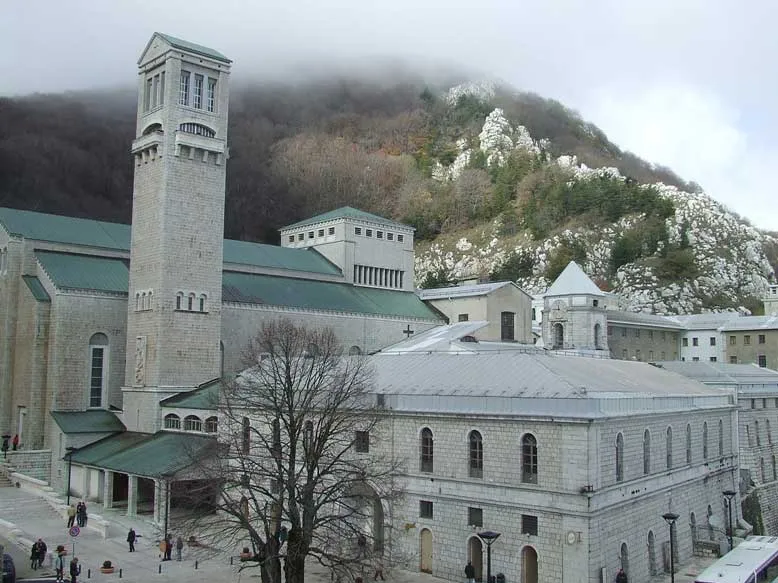
Introduction
The Sanctuary of Montevergine is a Marian monastic complex of Mercogliano, located in the hamlet of Montevergine it is a national monument. The territorial abbey of Montevergine is one of the six Italian territorial abbeys. Inside, the painting of the Madonna di Montevergine is venerated and it is estimated that every year it is visited by about one and a half million pilgrims.
The Montevergine, also known as Partenio or Monti di Avella, is a limestone massif in Campania, central Italy, part of the Apennine chain. It is located near Avellino, in the comune of Mercogliano. It has slopes covered by chestnut and beech trees, up to some 1,480 m above sea level.
Under the peak, at some 1,270 m, is the Sanctuary of Montevergine, which attracts numerous pilgrims. It was consecrated in 1124 near the ruins of a temple of Cybele. The new basilica, built in 1961 by Florestano Di Fausto, is home to a 13th-century Byzantine icon of a black Madonna. The abbey palace was designed by Domenico Antonio Vaccaro, and has an octagonal plan. The Sanctuary is the cathedral of the Territorial Abbey of Montevergine. The sanctuary can be reached from the town of Mercogliano by the Montevergine funicular.
History of Sanctuary of Montevergine
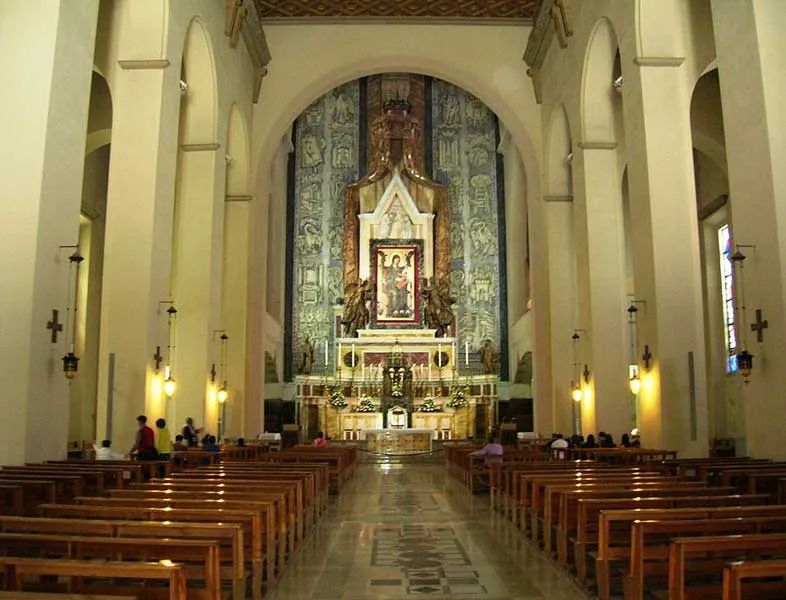
In the 12th century, the heart of the Christian Middle Ages, St. William embodies one of the highest images of the man of God. Apostle and pilgrim, perennially on the march, William dedicated his life, adventurous and imaginative in many respects, to spreading the Gospel in every place and in every kind of humanity. In the context of medieval Christianity, he represented a link between the experiences of the monks who guided the reform of the Benedictine order from the hermitages of Camaldoli, Vallombrosa and Chiaravalle, and the return to a more lively and spontaneous, simple and popular religiosity, better suited to interpreting the evangelical model.
For this reason William has often been associated with the figure of St. Francis, although the “poor man” of Assisi was born only forty years after the death of the founder of Montevergine. His apostolic work in southern Italy precedes that of St. Francis, however too scarce an iconography and literature, a fate common to that of many other precursors, does not give us today the right measure of the life and works of St. William from Vercelli.
The true story of the Sanctuary of Montevergine begins with the consecration of the first church by the Bishop of Avellino, when (as the first biographer expresses it) «the church was built and a large number of people gathered there for the service of God, behind the common opinion, William decided that the aforementioned church was dedicated to honor of Mary, Mother of God and ever Virgin».
Therefore the Sanctuary of Montevergine owes its origin not to an apparition of the Madonna or something similar, but to that Marian ascetic spirit of San Guglielmo and his disciples, who, not without divine inspiration, wanted to build a beacon of devotion to the Madonna in Montevergine, consecrating a church on that mountain and dedicating the primitive monastery to her.
William, having lit the fire of God’s and the Virgin’s love on the sacred mountain, goes elsewhere as adviser to the powerful, rescuer of the humble, tireless worker in building the houses of the Lord and of his religious, who everywhere form a thick crown around him. His laborious earthly day ended on June 24, 1142, in the Monastery of Goleto, near Sant’Angelo dei Lombardi (Avellino). Soon many other monasteries arose under the control of the Monastery of Montevergine, thus developing the Verginian Congregation.
The XII-XIV centuries marked the maximum splendor of this institution: popes, kings, princes and great feudal lords vied with one another in enriching Montevergine, some with spiritual goods, some with generous gifts, some with large fiefdoms and sovereign protection. The Congregation suffered a lot during the Great Western Schism (1378-1420), and so it began to decline, even taking a dizzying turn from the day in which the inauspicious commendation (1430-1588) made the responsibility of the abbey government pass on men who had no other interest than to receive the generous prebends of the benefits assigned to them.
This fatal descent was attempted to be curbed after 1588 with a second period of awakening and vitality; but later other factors intervened, An aura of mystery envelops the history of the icon of Montevergine, many legends follow one another over time attributing various authors to it, as well as multiple intercessions thanks to which the painting would have arrived at the Sanctuary of the same name.
Since the seventeenth century, credit has been given to the legend that this icon was painted up to the chest directly by the hand of Saint Luke in Jerusalem, then exhibited in Antioch and finally transported to Constantinople, the current Istanbul. During the eighth century, following the establishment of Michael Palaeologus on the throne of Constantinople, the fleeing emperor Baldwin II allegedly had the head of the painting severed, taking it with him during his exile. Thus he saved it from certain destruction by the iconoclasts who in that period gave a close hunt for all the sacred images.
The image of the face of the Madonna would thus have come, by inheritance, into the hands of Catherine II of Valois, who after having it completed by Montano d’Arezzo, in 1310 would have donated it to the monks of Montevergine, having it placed in the noble chapel of the Anjou. During the Second Vatican Ecumenical Council (1962-1965) the ecclesiastical authority entrusted some critics and art historians with the task of establishing the correct authorship of the painting and of determining the period in which the Sacred Image would actually arrive in Montevergine.
The legend of the Sacred Icon soon lost its consistency because it was disputed in several points. First of all, in 1310 Catherine II of Valois was just ten years old and only three years later she will marry the Angevin prince Philip II of Taranto; it is therefore difficult to believe that Caterina, so young, could have commissioned Montano d’Arezzo to complete the painting. Furthermore, a parchment conserved in Montevergine demonstrates the presence of the painting at the Sanctuary as early as the end of the thirteenth century.
In one of his studies in 1964, Father Giovanni Mongelli, of the Congregation of Montevergine, hypothesized that the authorship of the painting could be attributed to the famous Roman painter Pietro Cavallini, or to his school, both for the presence of some distinctive stylistic elements of his technique pictorial – such as the Byzantine intonation and the typical way of drapery, both for his proven activity in that period at the Anjou court. The presence of Angevin lilies around the image of the Virgin unquestionably links its pictorial origin to that ruling house.
Unanimous in their judgment, the historians have therefore refuted all those legends that arose in the Middle Ages which attribute the divine intercession of the Madonna to the discovery of the canvas; as well as the one who wanted the Sacred Image to arrive right at the Sanctuary because the mule that was carrying it opposed the commands of the knight, placing itself on the road that led to Montevergine. However, these legends that lead back to the miraculous discoveries of the Sacred Image remain firmly rooted in popular tradition, helping to create an indescribable mystical sense around the painting and thus increasing its cult and veneration.
The Ancient Basilica
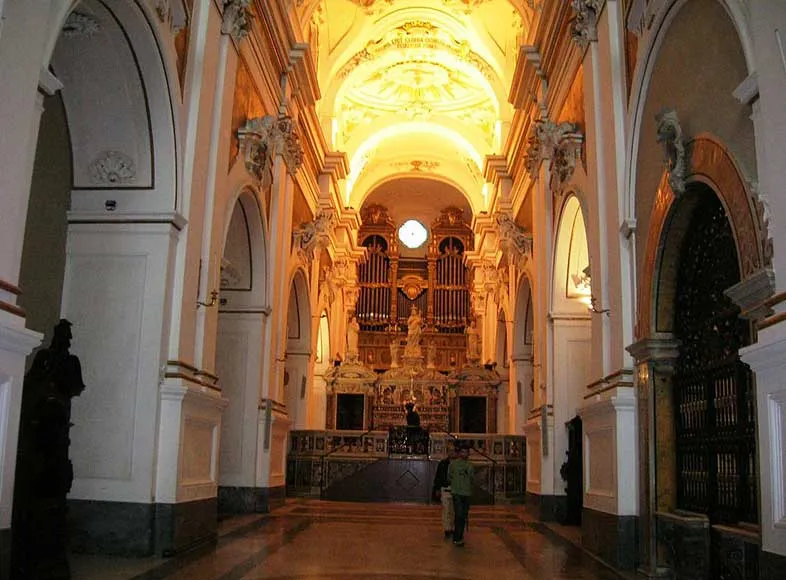
The visit to the ancient Basilica proceeds according to the original layout, starting from the covered atrium, which is delimited by the wide reach of the iron gate (made by the De Lamorte foundry in Naples, based on a design by the engineer Felice Treicher in 1885), also marked by the Gothic style, to adapt it to the portal of the Basilica. Inside, six marble plaques in Latin: the first, placed at the top left, summarizes the history of the Sanctuary as it was narrated in the eighteenth century; the second, located on the right, is to be considered an act of reverence by the Cassinesi Fathers PO to Pope Leo XIII, benefactor of Montevergine.
Four other tombstones, placed from left to right, summarize respectively:
- The dedication expressed by Francis I to the Sanctuary with his devout pilgrimages;
- The gratitude of the Fathers to Ferdinand IV for the restoration of the Diocese of Montevergine;
- The visit of Vittorio Emanuele III to the Shrine on August 28, 1936;
- The frequent visits of Umberto di Savoia to the Sanctuary.
The Cathedral Basilica
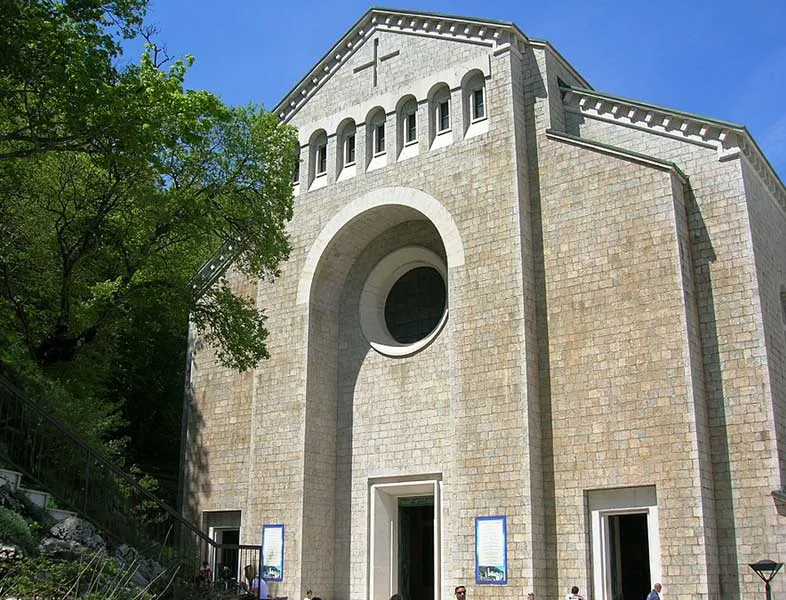
The construction works of the cathedral basilica began in 1952, and ended in 1961 with the solemn consecration on Ascension Day: the basilica is the work of the architect Florestano Di Fausto. The facade, divided into three compartments where as many entrances open, is covered in white stone and in the center there is a rose window decorated with polychrome glass depicting the coronation of the Virgin.
Inside it has no particular elements of relief, it has a neo-Romanesque style and consists of three naves, a central one and two lateral ones divided by means of five arches on both sides: at the bottom of the two lateral naves there are two galleries on which placed the organ. The main altar is enclosed by a wooden choir in walnut and olive briar, while at the back is the marble throne where the painting of the Madonna di Montevergine was placed, later replaced by a nailed crucifix: the frame that previously housed the painting she is surrounded by two angelsin marble that seem to support it; the altar is completed with polychrome marbles, bronze bas – reliefs and a mosaic by Hainal.
The ceiling is coffered with pure gold finishes, while the flooring is in semi- gloss granite. The windows of the lantern are decorated with stained glass representing Angels made by Amalia Panigati, who is also responsible for the crosses of the women’s galleries symbolizing the Evangelists. From the left aisle you enter a sort of side chapel called the Penitentiary, while at the end of the right aisle you have access to the old basilica through a Gothic-style portal, dating back to the 13th century, in whose tympanum the descent of the Holy Spirit on the Apostles and Mary Most Holy during the first Christian Pentecost is frescoed.
Near the new basilica, the bell tower, inaugurated in 1925, even if part of the facade had already been completed in 1901: about 80 meters high and covered in white and gray granite, the lower part is in Ionic style with three arches decorated with columns, while the upper part, where the papal loggia is also located, protected by a marble parapet, is in the Corinthian style; internally it is divided into five floors and on the external walls there are some decorations such as trumpeting angels and a marble representation of the Sacred Heart of Jesus, six meters high.
On the two galleries on either side of the apse, there is the Mascioni pipe organ opus 1042, built in 1981. The instrument, with electric transmission, has three keyboards of 61 notes each and a concave-radial pedal board of 32 notes.
The High Altar
On the main altar the admirable Neapolitan inlays, with arabesque lines decorated with mother-of-pearl agate and lapis lazuli. On the highest wall is the life-size statue of the Madonna delle Grazie flanked on either side by San Guglielmo and San Benedetto. The altar is adorned by two angels in the act of holding candlesticks, placed in 1888 to replace the wooden originals.
The Main Portal of The Basilica
From the Gothic portal of the late thirteenth century, pointed arch in white marble, built at the behest of the reigning House of Anjou of Naples, you enter the Ancient Basilica. In the tympanum is the admirable fresco depicting the descent of the Holy Spirit upon the Apostles and Mary Most Holy during the first Christian Pentecost, to commemorate the consecration of the first church of Montevergine, which took place precisely on the day of Pentecost. The solid pine door is believed to be that of the church consecrated in 1182.
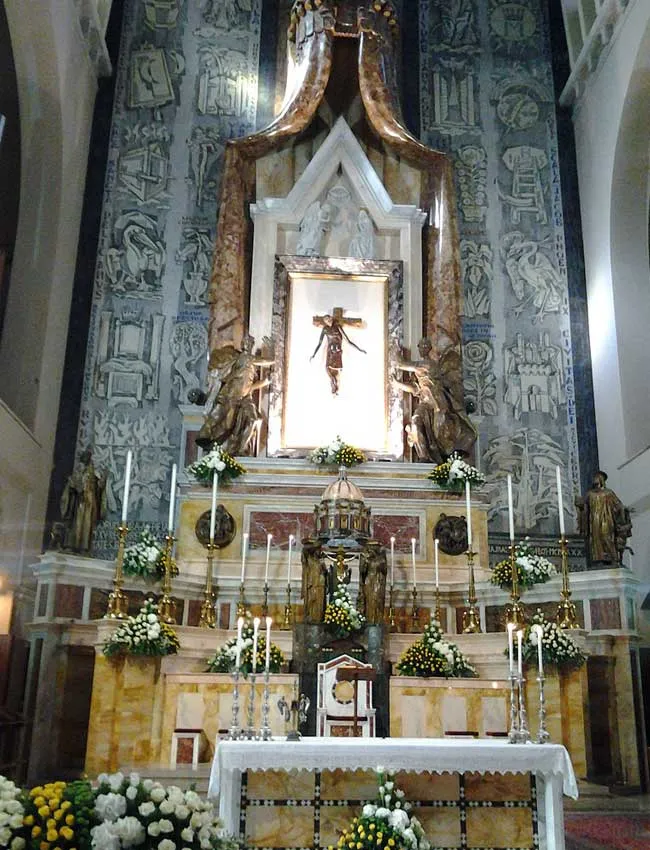
The Wooden Choir
Behind the high altar is the choir entirely in walnut from 1573, made by the workshop of Benvenuto Tortelli, with two rows of seats. To be observed carefully in the upper seats are the small columns, the putti lying on the armrests and the Angel with the sprinkler under the central prie-dieu.
The Organ
The Sanctuary boasts a long tradition of organs; the one kept in the Ancient Basilica was built in 1896, by the Zeno Fedeli company of Foligno. It consists of two manuals, each with 56 notes, 29 real registers, 1730 hammers, pedal board with 27 notes, 9 mechanical registers. The architect Paragallo executed the rich gilding on the façade designed by the architect. Vincent Welcome.
The organ kept in the New Basilica was built by the Mascioni firm in 1982.
The Canopy
In the right aisle is the chapel of the Santissimo with the elegant Romanesque-Cosmatesque canopy (13th century), probably donated by Maria of Hungary (wife of Charles of Anjou) or by her son Charles Martello. On the lower columns and on the architraves, four white bars on a red field depict the four tributaries of the Danube, the ancient coat of arms of Hungary.
The Cosmatesque style columns are supported by four marble lions; the eight columns of the architrave from which protrude two small statues supporting the thurible and the sprinkler are also Cosmatesque. Below the canopy, the custody of Luigi III De Capua (late 15th century), where in its front part two angels are placed in the act of supporting the ciborium elegantly closed at the sides by two small columns.
The Chapel of the Madonna of Montevergine
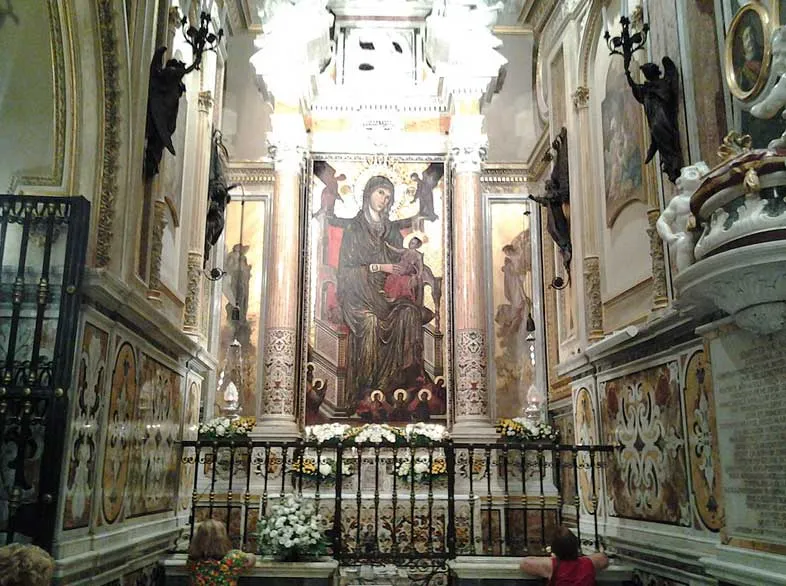
In the right aisle, from the closure of which the Chapel of the Madonna (later of the Crucifix), built by Filippo di Taranto in the XIII century, was conserved the sacred image of the Virgin. It therefore remained called the Chapel of the Madonna until 25 November 1960, when the sacred icon was placed in the new Basilica and a Crucifix from 1710 was placed in its place, which gave the chapel its current name.
The visitor’s eye will be fascinated by the grace of the two marble columns, by the two figures of the apostles Matthew and Luke, as well as by the stupendous 1628 Neapolitan altarpiece, with the image of the Madonna in the centre. On the right wall of the presbytery is the canvas by Vincenzo Volpe The Apparition of the Savior to San Guglielmo and again, placed in the upper part, four representations of San Bernardo di Chiaravalle, San Ildefonso di Toledo, San Pier Damiani and San Anselmo da Aosta.
Under the vault of the nave, depicting the Assumption, the Immaculate and Mary as a child, three frescoes also by Volpe, and on the choir the splendid canvas depicting the Nativity of the Lord. On the right wall, majestic and solemn, the funeral monument to Ludovico D’Angiò, King of Naples and to mother Catherine II of Valois and his sister, Princess Maria. A marble niche preserves the mortal remains of Abbot Guglielmo De Cesare. On the facade of the choir, two plaques recall the legend of the Virgin’s head and the restoration work carried out on the chapel at the end of the 19th century.
The Crypt of San Guglielmo
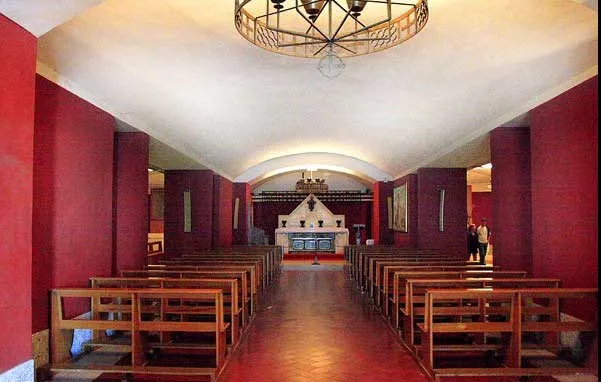
The crypt of San Guglielmo, which consists of three naves, was consecrated in 1963. The main altar is dedicated to the Saint, under which is the valuable urn that contains his mortal remains, and on which the most salient scenes of the his life. In the naves there are eight altars, consecrated in 1964, each dedicated to two saints: Sant’Eleuterio and Sant’Antia, Santa Giuliana and Santa Faustina, San Costanzo and San Deodato, San Barbato and San Massimo, San Giasone and San Mauro, San Mercury and San Potito, Sant’Ermolao and San Modesto, San Vittore and San Prisco. On the walls of the naves, the relics of the Sanctuary of Montevergine are kept in urns.
Ex Voto Room
Similarly to the construction of the new Basilica, the creation of the Sala di San Guglielmo was proceeded (on the walls of the passage from which it is accessed are preserved the countless ex-votos that were placed until 1960 on the image of the Madonna di Montevergine, which demonstrate the divine intercession of the Madonna in the granting of graces and miracles).
Before entering the hall, still in the passage, the body of the “blessed” Julius is kept in a bronze urn, which, although without embalming, is still kept in good condition. The popular cult attributes many miracles to him, but the ecclesiastical authority has not yet ruled on the matter and has not yet conferred on him the title of “blessed”: it is therefore a matter of an unrecognized personal cult of the faithful.
Madonna of Montevergine
The Madonna of Montevergine is the name with which the painting depicting the Virgin Mary seated on a throne with the child Jesus in her arms is venerated in the sanctuary of the same name in Mercogliano, dating back to the XIII – XIV century: in addition to the name usually it is also known as the Black Madonna or, more commonly, as Mamma Schiavona. Contrary to what one might think, the cult of the Madonna of Montevergine is not linked to any apparition, but only by the will of a hermit monk, Guglielmo da Vercelli, to dedicate his life to prayer through the cult of Mary, forming in a short time a real monastic order.
History of Madonna di Montevergine
The history of the icon of the Madonna di Montevergine is uncertain: according to legend, the picture was painted directly by St. Luke in Jerusalem, to then be transported first to Antioch and then to Constantinople: in the eighth century, however, with the accession to the throne of Michael Palaeologus and the beginning of iconoclasm, the fugitive King Baldwin II severed the head of the Madonna from the painting to save her.
Bequeathed to Catherine II of Valois by inheritance, she had Montano d’Arezzo finish the work, to then donate it to the monks of Montevergine in 1310, exhibiting it in the noble chapel of the D’Angiò.
The first real historical evaluation of the icon only took place during the Second Vatican Council, in the sixties, when a team of historians and critics analyzed the picture on the orders of the ecclesiastical authorities: soon the legend turned out to be totally unfounded as the date of donation the sanctuary could not be exact because Catherine II would have been only ten years old and also from a writing preserved in the Irpinia monastery, the picture was already present from the end of the XIII century.
In 1964 Giovanni Mongelli, father of the Congregation of Montevergine, hypothesized that the work could have been created by Pietro Cavallini , or in any case by his school, given the numerous artistic elements typical of the Roman painter, such as the Byzantine style and the way of drapery, but this he hypothesis was also dictated by the fact that Cavallini had often been commissioned to create works by the D’Anjous, a family to which the work certainly belongs given the presence of the Angevin lilies; in 1997 Father Placido Maria Tropeano, however declared that the work could also be attributed to Montano d’Arezzo, but which as a result of continuous alterations has lost its initial appearance.
The image of the Madonna di Montevergine was created on two pine tables held together by some bars on the back and has a height of 4 and 30 meters and a width of 2 and 10 meters. The representation represents the Madonna, seated on a throne, with the child Jesus in her arms, placed on her left leg and the child holds, in his right hand, the mantle of the mother: both the head of the child and that of the Madonna they are haloed, but while in the first case there is still a gold crown donated in 1712 by the Chapter of St. Peter’s in the Vatican, while in the second it is absent due to a theft that took place in 1799.
The face of the Virgin is ovoid in shape and her eyes are black with the characteristic of observing both the sky and the child she carries in her arms at the same time. In the upper part of the picture there are two angels flying on the edge of the throne, while six others are at the feet as a sign of veneration and prayer; on both sides of the throne there are two medallions which respectively preserved the Virgin’s mother’s milk and a piece of her cloak.
Over the years the painting has undergone numerous remakes, which have altered its original structure, as evidenced by some restorations which have ascertained the presence of paint in the underlying layers: in 1621 two more crowns were placed on the heads of the Madonna and of the child, which came to be three in 1712; in 1778 two gold plates were placed on the sides of the throne. On the night of 17 and 18 May 1799 the painting was stolen and after its discovery it was embellished with brass necklaces and pettiglie, removed following the 1960 restoration and kept in the museum of the sanctuary; a further restoration took place in 2012.
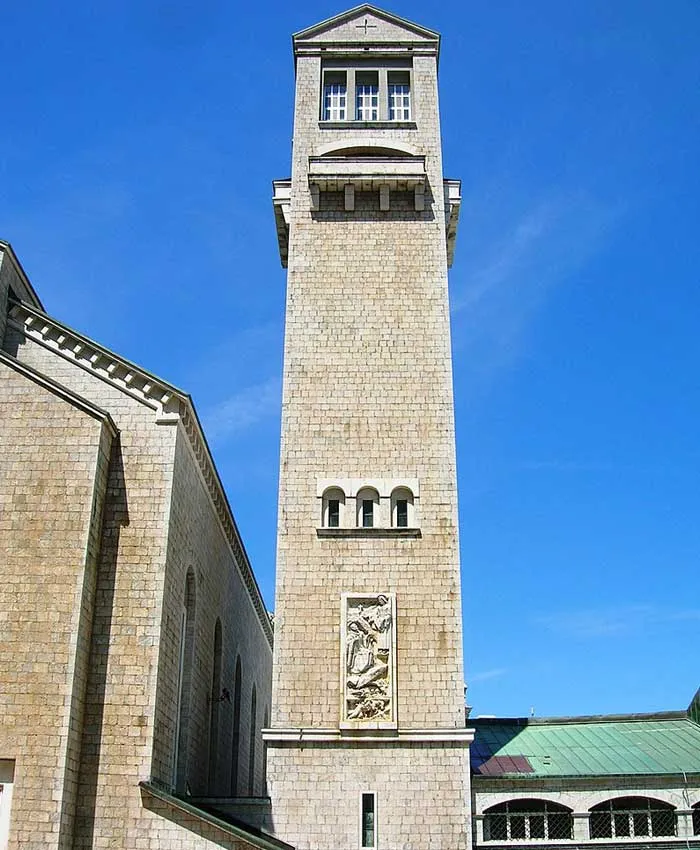
Devotion and Pilgrimages
Pilgrimages to Montevergine are a deeply rooted tradition not only in Campania, but also throughout the rest of southern Italy: the first evidence of ascents to Mount Partenio already dates back to the time of Guglielmo da Vercelli when small communities of people came to the church especially to get to know the virtuous saint; in 1139, in a document, it is said of pilgrimages to invoke divine grace and on 12 September 1263, Pope Urban IV, affirms how the area of Montevergine has become an important center of prayer.
The constant flow of pilgrims over the years also brought benefits downstream, so much so that numerous buildings were built in the areahostels: today this place takes the name of Ospedaletto d’Alpinolo, deriving from the high number of reception centers.
The pilgrimages carried out in the past, both in carriages and with carts, horses or on foot, were characterized by fasting or abstinence from meat, eggs and cheeses; another tradition wanted women or girls not yet married to go on pilgrimage, who intertwined broom branches during the ascent to the mountain, promising the Madonna to return the following year and to untie the knot in the company of the groom or even that very young girls went barefoot to the sanctuary on behalf of third parties to thank the Virgin for the grace received. During the descent, the men used to perform a chariot race, called recanata, while the women sang popular songs.
Another festivity felt in the cult of the Madonna of Montevergine, also called Mamma Schiavona, is that of Candelora: it is said that in 1200, during a snowstorm, a couple of homosexual lovers had been discovered and imprisoned in a tree on the mountain with slabs of ice: through the intercession of the Virgin, a sudden ray of sunshine struck the slab, melting it and saving the two lovers: from that day, every year, on the occasion of this festivity, gays, lesbians and transsexuals, pay homage to Mamma Schiavona with a pilgrimage to the sanctuary, called juta dei femminielli, to then participate, together with the other pilgrims, in the dances, especially tammorriate, which take place in the square in front.
Feast Day - 2nd February
Every year the Madonna of Montevergine is honored with a grand two part festival, which opens on February 2nd, the “purification of the Virgin” during Candlemas, and closes on September 8th, the birthday of Mary (or on the closest Sunday to it). The events draw thousands of faithful and the stream never stops. All together about two million pilgrims come to Montevergine every year. They couldn’t be a more varied bunch and they don’t always get along very well. There are monks, nuns, lay people, local peasants, foreign tourists, the Pope, droves of Naples’ homosexuals, you name it.
Many spend the night before the “festa” in Alpinolo, the nearest town to the abbey, so that they may be ready to attend the “sagljuta” (salute) to the Madonna the next morning. They await that hour with songs and dances in parks and other public places. The next day colorfully decorated floats make their way up the mountain to the monastery. They are drawn by oxen or horses and accompanied by singing and tambourine rhythms which give thanks to the Black Madonna, praising her as Our Lady of All Graces. The pilgrims sing and dance up and down the stairs of the sanctuary until they come face to face with the Madonna.
Mass Time
Weekdays
Sundays
Church Visiting Time
Contact Info
Via Sanctuary, 83013 Mercogliano,
Province of Avellino, Campania, Italy
Phone No.
Tel : +39 0825 72924
Accommodations
How to reach the Sanctuary
Naples International Airport in Southern Italy is the nearby airport to the Sanctuary.
Avella Train Station in Sperone, Province of Avellino, Italy is the nearby Train Station to the Sanctuary.

